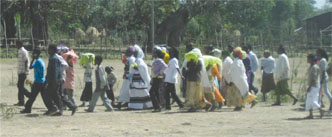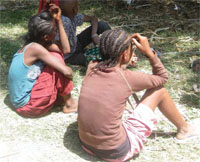11.3.1 Demographic data
Demography, which was introduced in Study Session 10, is the scientific study of characteristics and dynamics pertaining to the human population. These characteristics include births, deaths, age, income, education and gender. Other relevant characteristics include occupation, family size, housing, ethnicity, language and religion. As a Health Extension Practitioner you need to collect data on these characteristics. Demographic factors are among the easiest to measure and are the most widely used basis for subdividing population groups.
Some of the demographic data that you will collect and report in a community profile for the health system include the following.
Age distribution of the community
Data collection for the health system typically categorises the population of a country, region or local community into fixed age ranges in years as follows: 0–4, 5–9, 10–14, 15–19, 20–24, 25–29, 30–34, 35–39, 40–44, 45–49 and 50 years and above.
Using this type of classification, which age range data do you need at Health Post level to plan for immunization programmes to protect against vaccine-preventable diseases such as tuberculosis, measles and polio?
Children in the age range 0–1 year are the target group for these immunizations, which protect against some major childhood infections. You need to know how many children in the kebele are in this age range so you can plan your immunization service effectively, and without wasting vaccines by ordering too many vials.
Gender
Gender is the term used to identify whether a person is male or female. Classification of the population in your kebele into the two genders is useful in your community profile because it enables you to plan for gender-specific services (Figure 11.3).

Can you think of any types of health service or health education that are focused mainly on one gender?
You may have thought of antenatal care, labour and delivery care, and postnatal services, which are provided for women. You may also have thought of health education programmes focused on educating men about the dangers of alcohol abuse or cigarette smoking, since these activities are rare among rural women.
Family size of the household
One reason for classifying households on the number of people living there is that it gives you some information on the type of health services they may need. For example, if the household has a large number of children, you may need to focus your health messages on advice about family planning to limit their family size. In developing countries like Ethiopia, limiting family size using contraceptives is one strategy to alleviate poverty, prevent sexually transmitted diseases, and reduce the risk of pregnancy-related deaths and under-five child mortality.
Can you think of any other reasons why knowing household size could be useful in organising the provision of healthcare?
If a household is overcrowded (too many people living in a small space), there is a greater risk of transmission of diarrhoeal and respiratory diseases through lack of hygiene, and close contact with anyone who is coughing or sneezing. If there are many mouths to feed, there is a greater risk of malnutrition affecting health, particularly among the children. Knowing which households are at greatest risk enables you to focus your home visits and use your time more efficiently.
Income
The health-promoting behaviour of people in your community can be affected by family income; for example, it affects the quality and quantity of the diet they can afford, and whether they have the money to build a latrine. Also, those with a good income can afford to seek health services if they are ill; poor families may not be able to afford the costs of transport to the health centre, or the charges for drugs or items such as surgical gloves.
Occupation
Collecting data on occupations in each household can give useful information about potential health risks and the likely needs for health services. Some occupations have direct impacts on health. For example, farmers and labourers are at higher risk of accidental injury from tools and heavy weights; people working at leather tanning are exposed to hazardous chemicals and possible infection from the hides. Don’t forget that the nature of your own work may put you at risk of health problems. For example, as a health professional, you are at risk of infection if you do not practise infection prevention techniques such as regular handwashing with soap, and using surgical gloves when dressing an infected wound or delivering a baby.
Religion
Some Christian churches will not support the use of condoms for family planning, or to prevent the transmission of HIV. This is one example of how a person’s religion can influence their health and demonstrates why recording the religion in a household is part of the community profile.
Educational status
The educational attainment of girls is particularly important to record in the community profile for several reasons. Better education generally enables people to understand and accept health education messages; it can also lead to better employment and higher income. Female education is associated with improved survival rates of a woman’s children and increased uptake of family planning. It is also associated with delay in the age of marriage and therefore delay in the birth of the first child (Figure 11.4).

Can you suggest why delayed first birth is beneficial to the health of both the mother and the baby?
Very young girls can have difficulty giving birth because their bodies have not yet developed sufficiently; this poses a risk to them and to the baby. Delaying the first birth until the girl is older gives a better chance of survival for them both.
11.3 What types of data will you collect for a new community profile?
